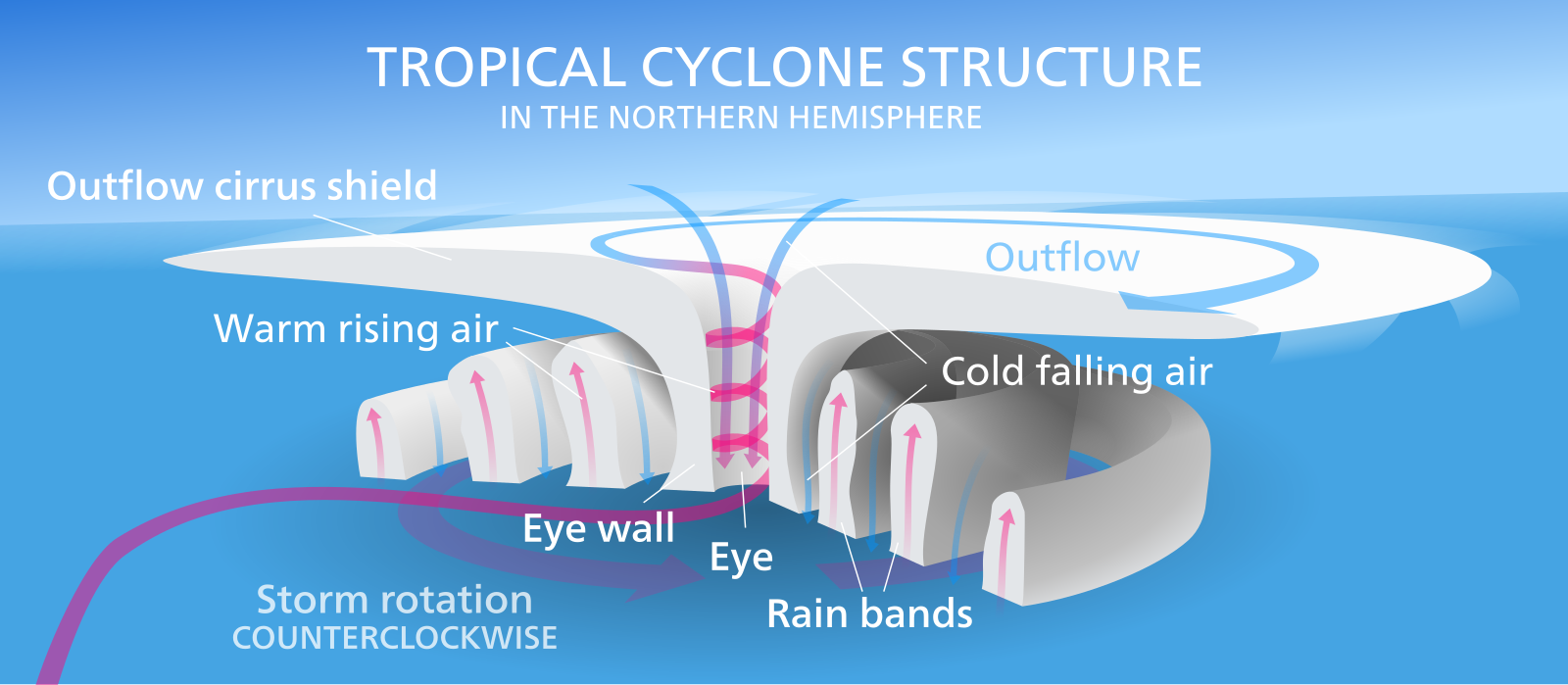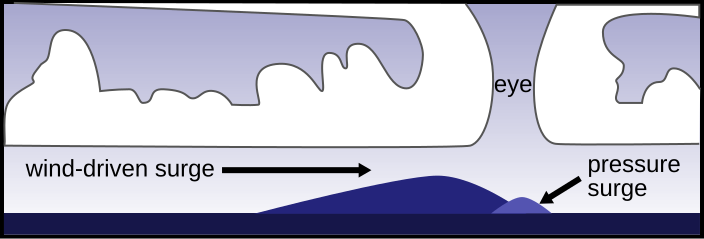IB Syllabus focus:
‘Rapidly rotating low-pressure storms; classed as hurricanes/typhoons at ≥119 km/h sustained winds. Warmer oceans/air increase storm intensity and often frequency.’
Tropical cyclones are among the most powerful natural hazards on Earth, driven by warm oceans and atmospheric instability. Their intensification highlights crucial climate–ecosystem interactions relevant to global sustainability.
Tropical Cyclones: An Overview
Tropical cyclones are large, rotating storms that form over warm tropical oceans. They are characterised by strong winds, heavy rainfall, and low-pressure centres. These systems are also known regionally as:
Hurricanes in the Atlantic and Northeast Pacific
Typhoons in the Northwest Pacific
Cyclones in the Indian Ocean and South Pacific
Tropical Cyclone: A rapidly rotating storm system originating over tropical seas, with low pressure, organised convection, and sustained winds ≥119 km/h.
The threshold of 119 km/h distinguishes a tropical cyclone from weaker tropical storms or depressions. This wind speed classification is critical in hazard monitoring and preparedness.
Structure of Tropical Cyclones
Tropical cyclones exhibit distinctive internal features that influence their behaviour:
Eye: A calm, clear centre with descending air and low pressure.
Eyewall: Surrounding the eye, this zone contains the strongest winds and heaviest rainfall.
Rainbands: Spiralling bands of clouds and precipitation that extend outward.
The release of latent heat from condensing water vapour fuels the storm, sustaining its rotation and intensity.
These features control wind distribution, rainfall intensity, and hazard zones.

Diagram showing the eye (subsiding air), surrounding eyewall (strongest winds and heaviest convection), and outer rainbands (bands of thunderstorms) that define a mature tropical cyclone’s structure. The airflow is indicated schematically and aligns with the description in the notes. Labels correspond to standard meteorological terminology. Source.
Formation Conditions
Cyclones require a unique combination of environmental conditions to develop:
Sea surface temperature above 26–27°C, providing energy.
Deep ocean layer (50 m or more) to maintain heat supply.
Coriolis effect to initiate rotation (minimal near the equator).
Low vertical wind shear to allow vertical growth of storm systems.
High humidity in the troposphere to encourage convection.
These factors explain why tropical cyclones are geographically limited and seasonally variable.
Intensification of Tropical Cyclones
Tropical cyclones can intensify when environmental conditions become more favourable. Intensification is primarily influenced by:
Ocean warming: Higher sea surface temperatures increase energy availability.
Atmospheric warming: Warm air holds more water vapour, raising latent heat release.
Reduced wind shear: Allows more stable storm structure.
Positive feedback loops: Rising air leads to greater condensation, fuelling more uplift.
Intensification: The process by which a tropical cyclone increases in strength, measured through sustained wind speeds, central pressure drops, and rainfall intensity.
Climate Change and Cyclone Intensification
Human-driven climate change is altering cyclone behaviour. Warmer seas and atmospheres contribute directly to cyclone intensity and, in many cases, frequency. Key trends include:
Increased maximum wind speeds in many tropical regions.
More intense rainfall during cyclone events due to enhanced atmospheric moisture.
Greater storm surges, as higher winds and rising sea levels combine.
Poleward shifts of cyclone tracks in some basins.
These patterns highlight the sensitivity of tropical cyclones to the global energy balance.
Feedbacks and Hazards
The intensification of tropical cyclones amplifies ecological and human risks:
Storm surges: Coastal flooding caused by low pressure and high winds pushing water ashore.

Cross-section illustrating mean sea level, normal high tide, and the additional water level from storm surge, which together produce the storm tide experienced at the coast. The diagram highlights wind-driven set-up over a shallow shelf, consistent with the process described in the notes. This figure focuses on terminology and vertical reference levels only. Source.
Inland flooding: Heavy rainfall exceeding drainage capacity.
Wind damage: Infrastructure destruction, deforestation, and crop loss.
Ecosystem disruption: Coral reef breakage, mangrove destruction, and salinisation of soils.
Storm Surge: An abnormal rise of seawater above the predicted tide, driven by cyclone winds and low atmospheric pressure.
The interaction of stronger cyclones with already stressed ecosystems can push systems towards tipping points where recovery is uncertain.
Global Distribution of Risk
Not all regions are equally vulnerable. Tropical cyclone risk is shaped by geography and socio-economic conditions:
High frequency regions: Western Pacific and Bay of Bengal.
High vulnerability regions: Low-lying coastal nations such as Bangladesh and island states in the Caribbean and Pacific.
Lower exposure regions: Equatorial zones where Coriolis force is weak.
Vulnerability is compounded by population density, poor infrastructure, and limited disaster preparedness.
Monitoring and Prediction
Modern forecasting uses multiple tools to track and predict cyclone development:
Satellites for cloud patterns and storm tracking.
Doppler radar to monitor rainfall and wind speed.
Computer models that simulate cyclone paths and intensity.
Data buoys to record sea surface temperatures and pressures.
Such monitoring reduces risk by enabling early warning systems, evacuation planning, and resource mobilisation.
Tropical Cyclones and Global Sustainability
The intensification of tropical cyclones links to wider environmental and sustainability issues:
Energy balance of the Earth system: Stronger storms indicate increased atmospheric heat retention.
Human vulnerability: Population growth in coastal areas raises exposure.
Biodiversity loss: Storms damage habitats, contributing to long-term declines in ecological resilience.
Economic costs: Reconstruction drains resources from sustainable development initiatives.
These connections highlight tropical cyclones as not only natural hazards but also indicators of planetary-scale change.
FAQ
Tropical cyclones differ from mid-latitude storms because they draw energy directly from warm ocean waters, not from temperature contrasts between air masses.
They are also characterised by a warm core, circular symmetry, and a clearly defined eye in strong systems. Mid-latitude cyclones typically have frontal boundaries, while tropical cyclones do not.
Cyclones need the Coriolis effect to initiate rotation. At the equator, the Coriolis force is near zero, so storms cannot develop the required spin.
This explains why cyclone genesis usually occurs at least 5° latitude north or south of the equator.
In intense cyclones, a second eyewall may form around the existing one. The outer eyewall gradually contracts and replaces the inner one.
During the transition, winds often weaken.
After replacement, the storm may reintensify, sometimes becoming larger in size.
Cyclones act as massive heat engines, transferring thermal energy from warm ocean surfaces into the atmosphere.
They transport latent heat poleward and upward, helping to balance Earth’s energy budget. This process reduces ocean heat but increases atmospheric circulation.
Coastal development and deforestation magnify cyclone damage by removing natural buffers such as mangroves and wetlands.
Poor urban planning and inadequate drainage systems can worsen flooding. Social vulnerability, including poverty and lack of infrastructure, also intensifies the human toll.
Practice Questions
Question 1 (2 marks):
State two environmental conditions required for the formation of a tropical cyclone.
Mark scheme:
1 mark for each correct condition, up to a maximum of 2 marks.
Acceptable answers include:Sea surface temperature of at least 26–27 °C.
Deep ocean layer (50 m or more) to sustain heat.
Low vertical wind shear.
High humidity in the troposphere.
Presence of the Coriolis effect away from the equator.
Question 2 (5 marks):
Explain how climate change can influence the intensity and impacts of tropical cyclones.
Mark scheme:
1 mark: Identifies that warmer oceans provide more energy for cyclone intensification.
1 mark: Notes that warmer air holds more moisture, leading to heavier rainfall.
1 mark: Links rising sea levels and stronger winds to more damaging storm surges.
1 mark: Describes how increased intensity can cause greater ecological disruption (e.g., damage to coral reefs, mangroves, or biodiversity).
1 mark: Connects these changes to greater human vulnerability (e.g., increased flooding, economic costs, or displacement).
Maximum 5 marks.

